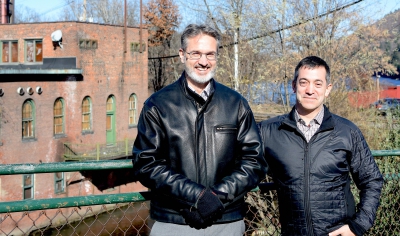Museum expansion: Reveling in Brattleboro
BMAC’s ambitious buildout does what no one else can do

Bob Stevens of M&S Development, left, and Danny Lichtenfeld, executive director of the Brattleboro Museum & Art Center, stand in front of 11 Arch St., a former power generation station that will be demolished to make way for a 55,000 square-foot building that will contain new gallery space and 24 housing units. (Photo: Randolph T. Holhut/The Commons)
The Brattleboro Museum & Art Center (BMAC) and M&S Development are embarking on a new $30 million, 55,000-square-foot building to be constructed at the foot of Main Street in Brattleboro, alongside a cascading waterfall in the Whetstone Brook.
The building will contain state-of-the-art museum galleries and classrooms, 24 apartments overlooking the Connecticut River, a cafe with outdoor seating, a rooftop sculpture garden, terraces, a footbridge, and a kayak launch.
“Twenty-first century community development must include not only housing, restaurants, retail, and offices, but also cultural and public spaces that draw people together and foster community interaction,” said Bob Stevens, principal at Brattleboro’s M&S Development, the development consultant for the Putnam Block Redevelopment Project in Bennington. “We know that investing in vibrant downtowns creates jobs, increases property values, and attracts young families.”
Brattleboro’s new building will feature museum facilities at street level and two floors below, with apartments on four floors above.
BMAC Director Danny Lichtenfeld noted that the design will be a “Welcome to Brattleboro” and take maximum advantage of its waterfront location.
“Brattleboro has a stunning waterfall in the heart of downtown, where the Whetstone Brook tumbles into the Connecticut River, but access is limited in such a way that very few people get to see it. It was therefore important to us that the new building be designed to enable museum visitors and the general public to get up close and personal with that dramatic feature of the natural landscape,” Lichtenfeld said.
With BMAC’s rotating exhibits and education programs expected to move into the museum’s new building, plans call for the grand main gallery of Union Station to be transformed into a long-term showcase of the artwork of Wolf Kahn and Emily Mason, renowned artists who have divided their time between New York and Brattleboro for the past 51 years.
“We believe there should be a place the public can go, year after year, to experience the extraordinary artwork of these two American masters,” said BMAC Capital Campaign Committee co-chair Margaret Everitt. “And where better than Brattleboro, the place they have spent the past five decades gaining inspiration and honing their craft?”
Lichtenfeld said he believes annual visits will double—from 16,000 today to roughly 35,000 when this transformation is complete.
“Predicting these things is as much an art as a science, but we have been studying the outcomes of other New England museum expansion projects, including Mass MoCA, the Shelburne Museum, and perhaps most interestingly the Center for Maine Contemporary Art in Rockland, Maine, an institution similar in many ways to BMAC, which saw a five-fold increase in visitorship following its 2016 relocation and expansion,” Lichtenfeld said.
In terms of what it will take for BMAC and M&S to turn their bold vision of arts-driven community and economic development into a reality, Lichtenfeld said, “This is a $30 million construction project. BMAC needs to raise $12 million in charitable gifts, and the housing ownership group led by M&S needs to secure $10 million to $12 million in equity and financing. We expect the remaining $6 million to $8 million to come from federal and state tax credits and grants.”
He added, “BMAC plans to raise $3 million in endowment funds, so our total fundraising goal is $15 million. Our capital campaign is off to a very good start, and we expect to continue raising funds through spring 2021.”
As quoted in The Commons, Stevens said that mixed-use buildings such as the new center are “part of making this whole downtown economy work.”
He said downtown economies traditionally thrived on retail, and observed that just as the retail landscape has changed with more online shopping, downtowns must shift their focus as well. He said cultural attractions, restaurants, housing, and places that offer experiences can fill the gaps transitional retail left behind.
“As the downtown goes, so the economy goes,” he added.





















































